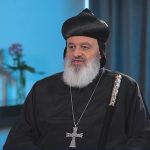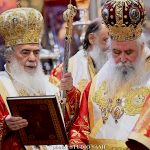By Amy Fallas – TIMEP-
Fourteen years ago, on October 9, 2011, Egyptian security forces violently attacked protesters in Maspero, killing 28 and injuring hundreds. There was one demand from the protesters and their loved ones that was respected, amid all the horror: receiving the wounded and dead at the Coptic Hospital.
The dilapidated Coptic Hospital on Ramses Street became a battleground the night of October 9, 2011. After Egyptian security and military forces attacked protesters—mostly Coptic Christians—at the Maspero Television Building on the Nile corniche, victims were rushed to spiritual and medical caretakers at the Coptic Hospital in frantic efforts to save those they could and pray over those they could not. The infrastructure at the hospital heaved with overworked medical staff, strained equipment and resources, and grieving loved ones. Outside, a scene of chaos ensued; the horror of the violence only increased as state television incited the public against the protesters to “protect the military” and, in a moment, turned neighbors against each other, Muslims against Christians, and transformed the hospital into a sectarian site under siege.
THE DEMONSTRATORS WERE PROTESTING THE DESTRUCTION OF A CHURCH IN UPPER EGYPT AND THE COMPLICIT ROLE OF EGYPTIAN AUTHORITIES AND STATE TELEVISION IN THE SPREAD OF VIOLENCE AGAINST CHRISTIANS
The incident, known as the Maspero Massacre, occurred when Egyptian military and security forces attacked hundreds of peaceful protesters with live ammunition and armored personnel vehicles in front of the Maspero building on October 9, 2011. The demonstrators were protesting the destruction of a church in Upper Egypt and the complicit role of Egyptian authorities and state television in the spread of violence against Christians. The demonstrators embarked on a march from the working class district of Shubra to the Maspero state media building in downtown Cairo. Twenty-eight Egyptians were killed and hundreds injured, most of them Copts. Amid the shock at the brutality of state violence, the Christian victims’ families insisted on treating the injured and transporting the dead to the Coptic Hospital despite other closer and better equipped medical facilities in proximity to Maspero. This demand and the events that transpired at the hospital is an aspect that is often overlooked in accounts and commemorations of the massacre that took place 14 years ago.
On that night, inside the hospital, battles raged on operating tables and in the morgue, between families, protesters, and religious leaders over preserving the bodies of the deceased and collecting evidence of state violence through medical forensic reports. In Alaa Abd El-Fattah’s reflection of the massacre, he wrote about the fight over the dignity of the dead as a struggle with “the clerics and priests of authority who preach that those who seek justice in this life abandon the right to it in the next.” He wrote about the connection with his fellow revolutionary, Coptic activist Mina Daniel who died that night, and how Mina “struggled from the afterlife” in solidarity with Alaa and other Muslims from Tahrir Square as they made their way into the hospital to capture evidence of the regime’s culpability in the violence against Copts at Maspero.
OVER 48 HOURS, THIS SERIES OF HORRIFYING EVENTS AND DECISIONS RENDERED THE COPTIC HOSPITAL INTO A CONTESTED SPACE WITH IMPLICATIONS FOR CHURCH-STATE AFFAIRS, CHRISTIAN-MUSLIM RELATIONS, AND THE POLITICS OF MEMORIALIZATION THAT CONTINUES INTO THE PRESENT
Activists engaged grieving families to convince them to request autopsies as the bereaved worried about preserving the bodily sanctity of the dead. They did so even as the Coptic Hospital did not have the facilities or practitioners to conduct the procedures and would require bringing an off-site forensics team. They embarked on this mission under the skeptical eye of clerics and others suspicious of religious outsiders amid their vulnerability and grief. Over 48 hours, this series of horrifying events and decisions rendered the Coptic Hospital into a contested space with implications for church-state affairs, Christian-Muslim relations, and the politics of memorialization that continues into the present.
The Maspero Massacre remains mired in what Miray Philips has called “the politics of memory” to refer to the official church and state narratives of what happened at Maspero as well as the censorship of commemorative acts. Official state narratives deny the military’s intentional use of brute force against protesters despite video and other documentary evidence to the contrary. The Coptic Orthodox Church under the leadership of Pope Shenouda III also enforced this narrative and, to this day, does not recognize the murdered Coptic protesters at Maspero as martyrs. Efforts to memorialize the martyrs has also been met with censorship such as in 2019 when the Egyptian Ministry of Interior asked the Coptic Orthodox Church to remove a memorial plaque of the “Maspero Martyrs” located near their graves due to its insinuation that the Egyptian army perpetrated violence against Copts. Although it was the families of the martyrs who erected the memorial, both the Church and the state actively suppressed even cursory efforts at memorializing and recognizing the martyrs.
Part and parcel of this politics of memory is also rooted in suppressing the sectarian and revolutionary histories of the places where the massacre took place: the Coptic Hospital and the Maspero Triangle. In the case of the Coptic Hospital, October 9, 2011, was not the first time the hospital became a contested site of sectarian implication. In fact, from its conceptualization during the late 19th century to its opening in 1927, the Coptic Hospital has been a fixture in the geographies of sectarianism in Cairo. The first Coptic Christian prime minister of Egypt Boutros Ghali established the Great Coptic Benevolent Society in 1881 with the goal of establishing a hospital for the Coptic poor. When they faced a myriad of challenges in erecting the hospital—not least among them unprecedented levels of sectarian tension during the early 20th century—they pivoted to a broader mandate to serve all Egyptians irrespective of their “religious sect or race.” These stages of the Coptic Hospital’s development and construction was marked by an awareness of the country’s sectarian dynamics and the need to present Coptic Christians as model citizens to mediate inter-religious conflict.
Maspero is subjected to a similar but different form of historical erasure that is currently endemic across Cairo: the destruction of material heritage under the guise of urban development. The Maspero Television Building and the surrounding area known as the Maspero Triangle have been subjected to an aggressive state-led campaign to reconstitute informal settlements in Cairo into “updated” and securitized zones. The Maspero Triangle was the first neighborhood impacted by these developments and was just one of many key sites of the 2011 Egyptian revolution that have been transformed and severed from its revolutionary past.
ALTHOUGH THE HOSPITAL WAS AT A FARTHER DISTANCE FROM MASPERO AND WAS NOT EQUIPPED FOR CERTAIN PROCEDURES SUCH AS AUTOPSIES, IT WAS AN INSTITUTION THAT COPTS COULD TRUST WITH NOT ONLY THEIR HEALTH, BUT ALSO WITH THEIR SAFETY, WITHIN A LANDSCAPE THAT TURNED AGAINST THEM IN SECONDS
During the horror at Maspero in 2011, there was only one demand from the protesters and their loved ones that was respected: receiving the wounded and dead at the Coptic Hospital. Although the hospital was at a farther distance from Maspero and was not equipped for certain procedures such as autopsies, it was an institution that Copts could trust with not only their health, but also with their safety, within a landscape that turned against them in seconds. The violence they experienced led them to seek care away from public institutions because what mattered most in this volatile environment was the assurance that their health and safety would not be jeopardized because they were Christian. In a tragic historical irony, a hospital established in the early 20thcentury to transcend sectarian discrimination became a garrison for Copts who were attacked for protesting for their rights in the 21st century.
Fourteen years later, several injustices of the massacre persist, from the denial of state culpability despite overwhelming evidence to the refusal of the Coptic Church to officially recognize the 28 killed as martyrs. These bureaucratic and legal injustices are intimately tied to ones over the politics of memory, including efforts to commemorate the dead, acknowledge systemic sectarianism in the state and society, and reconfigure contentious urban landscapes in Cairo. The thread that connects all of these dynamics is the refusal to acknowledge the past—revolutionary and sectarian—which is not only a prerequisite to attain justice for the victims of Maspero but to foster a reparative national dialogue to ensure another Maspero does not happen again.
__________________
Amy Fallas is a Chancellor’s Postdoctoral Fellow in the Department of History at UC Davis.





